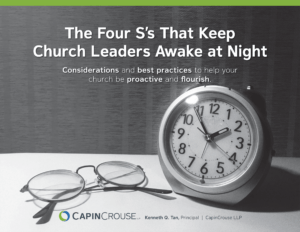
By Kenneth Q. Tan
The rapidly changing church landscape requires leaders to be more adaptive than ever. One key area for church leaders to address is sustainability: the long-term viability and growth of the church.
Here are several important sustainability factors to assess and consider.
Differences in generational giving
The demographics of the local church are changing dramatically as the population ages. According to the ECFA, giving to religion has declined since 1984, when it accounted for 57% of total charitable giving. In 2018, the percentage given to religion was 29%.
Church leaders need to understand the perspectives and ideals of each generation and what motivates them to give. Consider taking these steps:
- Survey your congregation’s generational makeup.
- Assess what motivates each generation to attend, participate, and give.
- Identify how you can better appeal to the concerns and motivations of each generation.
Time vs. money
Time and money are finite and never fully guaranteed. That’s why it’s crucial for church leaders to focus on strategic resource planning. Resources include finances as well as people and their time.
During the COVID-19 pandemic, churches and nonprofits focused on how they could cut costs while retaining staff members. Evaluate whether there are resource gaps you can fill by reallocating staff members’ time and talent to a different role.
Online giving and fundraising
The younger generations have grown up in a digital world. And as the pandemic showed, having alternate ways to stay connected with members and keep them engaged is crucial.
Look at overall trends in giving, including online giving, and assess:
- How might these trends apply to your church’s demographics and region?
- Are your giving trends in line with what you were forecasting?
- How are you maximizing social media to stay connected to your congregation? To reach your members’ connections?
Budgeting and forecasting

Your church’s ability to budget and forecast is another essential component of its sustainability. Here are some considerations to help make the process efficient and effective:
- Focus on your strategic plan. This should be the filter through which you make budget decisions.
- Start the process at least three months before the end of your fiscal year.
- Involve finance, senior leadership, and team and department heads.
- Underestimate revenue and overestimate expenses.
- Factor in “what-ifs” and reserves and use at least two to three years of historical results as a baseline.
- Factor in seasonality.
- Have team leaders write down “needs” versus “wants” for their areas.
- Make budget meetings collaborative and give departments time to review their respective area budgets before meetings.
Remember that the budget is a destination, not an absolute ending, and it will never be precisely accurate. Use it as a benchmark to discuss and explain what has happened.
Dashboards and benchmarks
It’s also important to review dashboards and benchmarks in many areas besides the budget. Dashboards provide valuable high-level information to key leadership and committee members. They also help you identify areas of potential concern (red flags) early.
We recommend looking at metrics in these areas:
- Liquidity — Can we cover all of our costs?
- Contingency — How much do we need to have as a reserve?
- Year-over-year comparison of financials — How are we trending?
- Membership retention — Are we losing more than we are gaining?
Legacy and planned giving
This goes hand-in-hand with the generational focus as retirees begin to consider their legacy. Gen Xers and Millennials are expected to inherit nearly $48 trillion in wealth in the coming years, according to research and consulting firm Cerulli Associates.
Look for ways your church can strengthen relationships with senior donors so you can be included in wills and inherit a portion of the wealth transfer.
Alternative sources of income
Some churches struggle with how to cover costs as basic expenses continue to rise and membership and contributions dwindle. As a result, many churches are looking for alternative ways to generate income, such as by:
- Renting out their facilities as a multi-use property
- Parking lot, cell phone tower, and office rental
- Church bookstores
Just keep in mind that there might be tax implications and seek the advice of a tax professional.
We’re also seeing churches consider mergers when they can no longer afford to operate independently. Combining resources and talent with a like-minded church can benefit both entities.
Finding peace of mind
Assessing and considering these sustainability factors will help position your church for long-term success. For additional insight on sustainability and other key issues, check out The Four S’s That Keep Church Leaders Awake at Night, a free e-book from CapinCrouse. It includes best practices, checklists, and discussion questions, among other resources.
Kenneth Q. Tan is a Principal at CapinCrouse LLP, a national CPA and consulting firm devoted to serving churches and other nonprofit organizations.
Ken has more than 11 years of public accounting and large nonprofit experience, providing both advisory and assurance services to various nonprofit entities, churches, and mission organizations.



